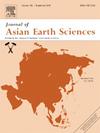Origin and evolution of the Qiangtang block, northern Tibetan Plateau: New insights from detrital zircon U-Pb geochronology and Lu-Hf isotopic compositions
IF 2.7
3区 地球科学
Q2 GEOSCIENCES, MULTIDISCIPLINARY
引用次数: 0
Abstract
Detrital zircon age spectra analysis offers insights into tectonic and sedimentary environments. In the Paleozoic sedimentary rocks of the Qiangtang block, northern Tibetan Plateau, we measured U-Pb ages of detrital zircons to elucidate the blocks tectonic-sedimentary evolution and its relationship to the Tethyan regime. Our findings reveal zircon age peaks at approximately ca. 2500, ca. 1600, ca. 970, and ca. 550 Ma, closely resembling the Cimmerian continent and exhibiting paleogeographic affinities with the northern margin of Gondwanan India. Our new data, alongside existing geological data, indicate distinct tectonic pathways for the North and South Qiangtang blocks since the Neoproterozoic as a result of Rodinia breakup. Our sedimentological and geochronological evidence implies that the Longmu Co-Shuanghu suture zone is an in situ ophiolite mélange formed by the closure of the Paleo-Tethyan Ocean.

求助全文
约1分钟内获得全文
求助全文
来源期刊

Journal of Asian Earth Sciences
地学-地球科学综合
CiteScore
5.90
自引率
10.00%
发文量
324
审稿时长
71 days
期刊介绍:
Journal of Asian Earth Sciences has an open access mirror journal Journal of Asian Earth Sciences: X, sharing the same aims and scope, editorial team, submission system and rigorous peer review.
The Journal of Asian Earth Sciences is an international interdisciplinary journal devoted to all aspects of research related to the solid Earth Sciences of Asia. The Journal publishes high quality, peer-reviewed scientific papers on the regional geology, tectonics, geochemistry and geophysics of Asia. It will be devoted primarily to research papers but short communications relating to new developments of broad interest, reviews and book reviews will also be included. Papers must have international appeal and should present work of more than local significance.
The scope includes deep processes of the Asian continent and its adjacent oceans; seismology and earthquakes; orogeny, magmatism, metamorphism and volcanism; growth, deformation and destruction of the Asian crust; crust-mantle interaction; evolution of life (early life, biostratigraphy, biogeography and mass-extinction); fluids, fluxes and reservoirs of mineral and energy resources; surface processes (weathering, erosion, transport and deposition of sediments) and resulting geomorphology; and the response of the Earth to global climate change as viewed within the Asian continent and surrounding oceans.
 求助内容:
求助内容: 应助结果提醒方式:
应助结果提醒方式:


